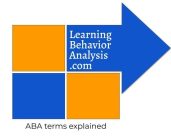B-11: Define and provide examples of discrimination, generalization and maintenance ©
Want this as a downloadable PDF? Click here!
Target Terms: Discrimination, Generalization, Maintenance
Discrimination
Definition: Occurs when a limited number of stimuli occasion a response. Discrimination skills are what we’re demonstrating when we put our food in the oven and not in the dishwasher.
Example in everyday context: A child says “daddy” when they see their father but does not say “daddy” when they see other men.
Example in clinical context: A behavior specialist is teaching their client to put away their laundry. The client sorts clothing by type (e.g., shorts, shirts, socks, etc.). The client sorts their clothing correctly without making any mistakes according to the clothing type. The client demonstrated discrimination based on clothing type.
Example in supervision/consultation context: A BCBA candidate is learning to discriminate between the two types of operant conditioning. After many hours studying, the student learns the difference between the two types of operant conditioning behaviors and can demonstrate this by sorting multiple examples into the correct categories.
Why it matters: Discrimination is an important aspect of learning that enables the learner to contact reinforcement. Some forms of discrimination (blue versus green) are fairly easy for most people to master, while other examples of discrimination skills (such as labeling all the countries on a blank word map, or telling the difference between the truth and a lie) can be more challenging.
Generalization
Definition: Occurs when a variety of stimuli occasion a certain response. generalization occurs across different individuals, environments, and times.
Example in everyday context: Greeting people in a variety of settings, times, and people (cashier at grocery store, librarian, person you pass while jogging, your spouse when they get home from work, etc).
Example in clinical context: A direct support professional is conducting a functional communication training with a client at a residential facility. The client begins to make requests with other direct support professionals who have not conducted the formal training with them. This is generalizations across individuals.
Example in supervision/consultation context: You are studying hard learning your ABA terminology. You begin to use these terms in your everyday language. This is generalization across settings.
Why it matters: Generalization is a critical element of learning. It is the reason why the human species have survived and been able to thrive in different environments. It can be helpful to think of generalization as discrimination’s counterpart. (Discrimination is at play when you select the brown ice cream rather than the white one when you want chocolate, and generalization is what’s involved in having little regard for which brown ice cream you choose, since they are all chocolate.)
Maintenance
Definition: Following the removal of an intervention, the extent to which a response remains in an individual’s repertoire over time.
Example in everyday context: A person learns how to ride their bike in their childhood and continue to maintain that skill into adulthood even though they may have not ridden a bike in many years.
Example in clinical context: A client is taught to read using evidence based interventions, and then maintains the ability to read over many years.
Example in supervision/consultation context: A supervisor teaches a group of supervisees how to use Habit Reversal Training/Comprehensive Behavioral Intervention for Tics. The supervisor teaches discrimination between examples and non-examples of each component skill, and supervisees learn to generalize the intervention by practicing across multiple individuals. Months later, the supervisor observes the supervisees demonstrating use of the intervention. The extent to which the skills are being done as taught is the extent to which those skills maintained.
Why it matters: Maintenance of learned skills promotes further learning opportunities since basic skills can be taught, mastered and built upon. It is absolutely crucial to consider naturally occurring reinforcement in the client’s goal environment when programming, since ultimately, we aim for the client’s behavior to maintain over time while relying as much as possible on naturally occurring forms of reinforcement.
